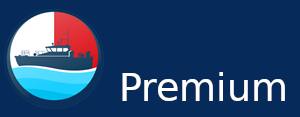The plus side is traffic is light. It only takes twenty minutes to complete a journey which, in normal times, take up to an hour. Furthermore, there is never a problem finding a parking space. Apart from a sprinkling of vehicles, the car park is nearly empty. Since, all the office staff are working from home, the cars belong to the essential workers: VTS staff, berthing officers and, of course, pilots. All frontline workers or, as one wag put it, quay workers. But none are more frontline than the pilots.
As the coronavirus epidemic crisis developed VTS, quite rightly, took early steps to protect and isolate themselves as much as possible. They banned visits, identified their own designated kitchen and washroom facilities. The design of the building, shared by other office staff and pilots, meant that a stairway and access was also restricted for their exclusive use. Berthing officers, the personnel responsible for the preparation of the berth and the correct positioning of the ship, could also maintain social distancing. With the government lockdown, the office emptied but until then pilots shared facilities with the rest of the staff.
For a ship with no declared cases of Covid-19, the boarding is pretty much as it has always been. Some pilots have always worn gloves climbing the ladder, some don’t. I don’t, preferring to grip the rope and stanchions with my bare hands. Where coronavirus has changed my habits is that as soon as I reach the deck I use my hand sanitiser. On the way to the bridge, I try to avoid touching doors and other surfaces. (These days I’m more than happy to step back and let the crewman open the door for me). And, of course, definitely no handshakes.
And what is the bridge team wearing? Masks? Gloves? Either? Both? Even now, a month into lockdown, there is still no clear-cut decision on the efficacy of either outside the clinical setting. Shipping companies and individual vessels have introduced their own individual requirements. An Italian tanker company, perfectly understandably, has introduced a quite stringent procedure. Before entering the wheelhouse I’m required to dip the soles of my shoes into disinfectant and don surgical gloves and mask. But none of the ship’s staff wore gloves or mask. A few ships have managed to acquire electronic infrared thermometers, so my temperature is checked before entry, (invariably, if the design of the ship allows, I now always taken up the external stairway). On other vessels all the bridge team were also wearing gloves and masks. But they removed the masks to smoke on the bridge wing and to drink their coffee. At no point did I see them sanitise their gloves, though they were all using the same equipment.
What is clear is that nearly all vessels are taking the crisis seriously. But not all. I will still board a vessel where life seems to have passed them by. No protective equipment worn,or expected to be worn by anyone. I’ve even had to refuse the Captain’s handshake. Though I have yet to meet the Captain who greeted a Cork pilot with the cheery welcome: “What’s the fuss, and why did you close all your pubs!”
This is written in the middle of the crisis, I hope. (It’s the fourth week of lockdown in the UK and I – and the rest of the world – hope there are not many, many more months ahead of us). But the World Health Organisation are now saying people’s actions will have to change once this pandemic is over. (It has been said that after the bubonic plague the British stopped greeting people with a kiss on the cheek). Does that mean the end of the handshake with the Captain before and after an act of pilotage? I hope not, and I remain optimistic. Mainly because traditions at sea remain strong. And although another tradition has at the moment been regrettably suspended, I look forward to the day when the first question I am asked when I walk on the bridge is: “How do you like your coffee, pilot?”


